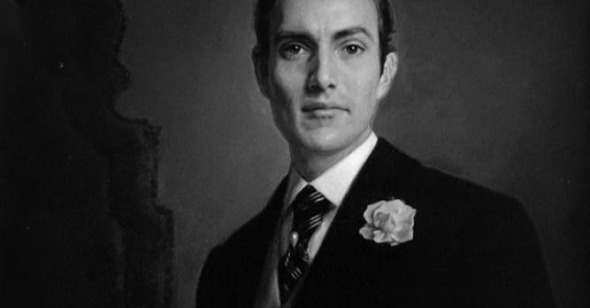First Night:
The Picture of Dorian Gray
“The moral life of man forms part of the subject-matter of the artist, but the morality of art consists in the perfect use of an imperfect medium.” —Oscar Wilde, preface to The Picture of Dorian Gray
From its classiest incarnations to its barrel-scraping lows, horror is perhaps our genre most concerned with moral questions. Their concerns can manifest as morality tales—featuring Faustian bargaining and overall bad decision-making in matters large (murder) or small (going into that strange house alone; feeding the gremlins after midnight); or they can be just plain moralizing, as in those slasher films-cum-cautionary tales that function as veiled chastity manuals for teenagers. In many of the greatest horror films there’s a moment when we say to ourselves, or to the screen, “She shouldn’t have done that!” or “I never would have done what he did.” Horror simply wouldn’t exist without the possibilities for poor choices and wrong avenues. Horror leads you down a path that’s been less taken for a good reason. Understanding this creates an active audience. This stretches from the stories of Irving, Hawthorne, and Poe to recent effective goosebump machines like Kill List, Sinister, and The Innkeepers.
There are surely examples in which unspeakable horrors befall innocents (including this year’s muddled Silent House, a purely experiential film that ultimately had no gut), but these rarely have as primal a pull as those that feel somehow instructional, that try to persuade that there is indeed a moral order: this is perhaps the most terrifying thought of all. Even in the most supernatural contexts it’s the rational we crave. True horror shouldn’t primarily be concerned with victimhood, but rather with the description of what happens when this precarious world is out of balance.
This seventh incarnation of our annual week-long series of recommendations for these late October nights—when the sun starts to set earlier and earlier, but the dark hasn’t yet been overtaken with twinkling Christmas lights—begins with a movie version of one of literature’s great morality tales, and an exemplary Hollywood horror movie. It should be no surprise that in 1945, MGM’s way of dealing with Oscar Wilde’s supernatural tale of male vanity and morbid eroticism The Picture of Dorian Gray was to highlight its dreadfulness, its uncanny terrors, and downplay its homosexuality. By emphasizing its Grand Guignol flourishes—of possession, murder, and the fantastic—this is at once both the most standoffish and nightmarish screen adaptation of Wilde’s book. And as directed by Albert Lewin, it’s also among the most breathtakingly composed and genuinely unsettling horror films of Hollywood’s golden age, featuring one of American cinema’s greatest bogeymen.
Though a pitch-black-hearted movie, The Picture of Dorian Gray opens in a room flooded with sunlight. This is the London studio of Basil Hallward (Lowell Gilmore), who is putting the finishing touches on his portrait of the story’s title. His sometime friend and all-around bad influence Lord Henry Wotton (George Sanders) has stopped by and, intrigued by the picture, demands to meet its subject. In Wilde’s book, both Hallward and Wotton’s aesthetic fascination with the beautiful young blond in the painting has an undeniably homoerotic edge; the artist admits his obsession with the lad has grown unhealthily all-consuming, and wants to protect him from the clutches of the bewitched Wotton, who seems to see in Dorian’s portrait a pure youth prime for the plucking. An aesthete spouting amoral aphorisms, Lord Henry is Wilde’s Mephistopheles figure, who, perhaps unwittingly and just by virtue of his commitment to his diseased ideals, leads Dorian down a path to rot. The decay of Dorian’s soul will not reveal itself on his person, only in the disintegrating, mysteriously aging face and body in the painting.
Onscreen we first glimpse Dorian from behind, as he is perched at a piano, playing Chopin, only the back of his head visible. According to Wilde, Dorian is “wonderfully handsome, with his finely curved scarlet lips, his frank blue eyes, his crisp blonde hair. There was something in his face that made one trust him at once. All the candor of youth was there, as well as all youth’s passionate purity.” In Lewin’s film, however, Dorian is embodied by the raven-haired, skeletal Hurd Hatfield, less handsome than placid, less trustworthy than maddeningly unreadable. With his socket-like nose, wide-set eyes, and expressionless countenance, he looks unformed, as though he’s still in the process of coming into being. No longer an object of desire, this Dorian is fearsome naiveté personified, a blank canvas onto which a tragedy of vice overtaking virtue will be sketched.
Apart from a clunky addition to the book concerning a mystical Egyptian cat statue that happens to be present when Dorian makes his devil’s pact (his wish to never age while the painting grows old) so as to grant the plot a semblance of a literal rationale, Lewin’s dramatization of the supernatural is provocative, even spine-chilling. This is partly due to the superb, Oscar-winning cinematography by Harry Stradling Jr., who gives each of the film’s vivid spaces exacting texture and depth: this includes Basil’s light-strewn salon; Dorian’s foreboding, neo-gothic home; the working-class tavern where Dorian meets the ill-fated chanteuse Sibyl Vane, played by a cherubic Angela Lansbury; and, in the film’s increasingly melancholy final act, the dreadful, Dickensian dockside area known as Bluegate Fields, realized in startling German-expressionistic set design. The film’s most shudder-inducing element, though, is its treatment of the titular morphing work. Lewin, not satisfied to merely employ the talents of the studio’s art department, hired important modern painters to create what would become the film’s most crucial props. What’s more, they burst onto the screen in isolated three-strip Technicolor shots, though the rest of the film is in shadowy black-and-white. The lushly designed likenesses of Hurd Hatfield that we see early on are the work of Portuguese painter Henrique Medina, both in its original, unsullied form and in its second, quite frightening incarnation. This comes after Dorian has followed Lord Henry’s advice and manipulated Sibyl in order to test her virtue; thus, after being rejected, she has committed suicide. Here, upon inspecting the painting, Dorian notices a slight alteration. There is a touch of cruelty about the mouth, subtle enough that one might not even notice, yet horribly apparent enough to for Dorian to cover his portrait and hide it in the attic.
Years, and nearly a half an hour of screen time, pass before we see the painting again. Meanwhile, Dorian’s corruption has grown to demonic proportions. In this time, we are left to only imagine what sorts of horrors are writ on Basil’s once graceful portrait. Lewin brilliantly draws attention to its absence, at one point subtly moving his camera to a low angle so that the attic door is visible near the top of the frame from the parlor during dialogue scenes, the ornate tentacles of the iron railing off the stairs surrounding the door with foreboding. When it is finally unveiled, in a shock cut to a Technicolor close-up, the picture has transformed into a startlingly unpleasant work by the American painter Ivan Albright. Featuring Dorian as a revoltingly desiccated old man with bared teeth, cracked and bubbling skin, haunted eyes staring straight out from the frame, bloodstained hands, and a mottled, rancid suit, the painting is a true horror—and not unlike other work by Albright. Something like the Midwest’s answer to Francis Bacon, Albright was an inspired yet natural selection to paint Dorian Gray, as he specialized in magical realist yet earthy illustrations unforgiving in their depictions of aging, death, and vanity. Among his most remarkable and haunting pieces are the funereal That Which I Should Have Done I Did Not Do (The Door), an elongated vertical canvas taken up entirely by a warped door decorated with a wreath of flowers and single grasping hand entering the frame from the left, and Into the World There Came a Soul Called Ida a meticulously grotty portrait of an aging woman with sagging flesh powdering her face before a makeup mirror, oblivious to time’s terrible toll. As the dreaded centerpiece of Lewin’s film, Albright’s ghastly painting makes furiously literal Wilde’s metaphorical notions about art, truth, and life. What makes The Picture of Dorian Gray such an effective horror film, as well as a fascinating interpretation of Wilde’s book, is that it confronts the viewer with a true work of art that represents the antithesis of the beauty we would usually seek. This is something that only a visual medium like cinema could do.
One final note: I had my own, real approximation of the film’s shock-cut to the painting when I recently visited the Art Institute of Chicago. Upon entering a gallery and making a beeline for Hopper’s Nighthawks, my husband tapped me on the shoulder and told me to turn around. There was Albright’s rancid, horrifying, chastising picture of Dorian Gray right behind me. I let out a gasp, as though a monster from my nightmares had suddenly appeared in my waking life. —Michael Koresky
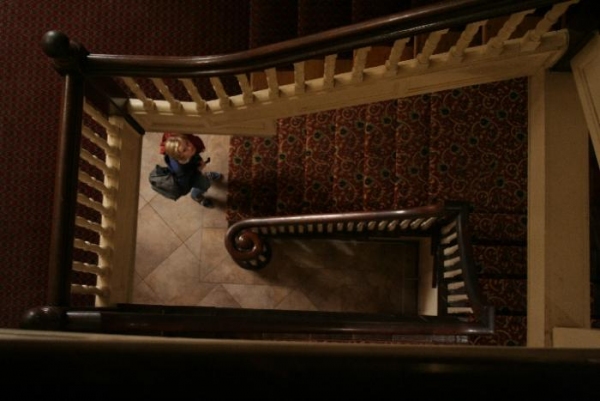
Second Night:
The Innkeepers
Early in The Innkeepers, director Ti West instructs the viewer to watch closely. The film’s button-cute leading lady, Claire (Sara Paxton), an employee at the Yankee Pedlar Inn, an old colonial-style hotel in Connecticut, has been summoned by her coworker Luke (Pat Healy) to watch a video on his laptop. He tells her it is a piece of found footage that claims to have captured evidence of a ghost, which might be of interest and use to Claire and Luke as the Yankee Pedlar is itself widely believed to be haunted by the melancholy jilted bride Madeleine O’Malley. Look closely, he warns her as she covers her ears with his headphones. The film’s frame is filled entirely with the computer’s black-and-white, slightly pixelated image of a room, a rocking chair dead center. The static image holds for ten full seconds, a cinematic eternity. We stare along with Claire, expecting the subtlest alteration in the shot, presumably in the rocking chair itself, which is sure to creak back and forth. Instead a ridiculous snarling demon face engulfs the frame and screams. Claire jumps away and rolls her eyes, Luke laughs; it’s a gag, much like those that circulated the internet about a decade ago.
However: this scene—which establishes characters, the setting, the story, and the tone of the film in one fell swoop—is not just a gag. It’s providing a lesson in how to watch the movie to follow. In other words, keep your eyes peeled and your ears open. At the end of The Innkeepers, the most eagle-eyed among us will be rewarded. Its final shot, the contents of which will only register to a select few audience members, and certainly repeat viewers, is an echo of that early grainy internet video, only this time there are no cheap shocks. It’s both technically and thematically a nearly perfect ending: it offers a delicacy of effect rarely afforded films of this kind and it makes its viewers into paranormal investigators, just like Claire and Luke. Unlike them, we get to go home happy.
As in West’s previous film, the instant classic The House of the Devil, the devil is in the details. Both horror movies have been cited for their “slow-burn” aesthetic, but it seems that West is more interested in giving his stripped-down plots and characters space to breathe and evolve; he’s aware that only in the accrual of information and particulars can a narrative make sense and people behave in relatable ways. Detractors of these two movies claim that “nothing happens” (the layman’s common art-film criticism) for a good long while, yet so much happens: we learn that Claire hates taking out the hotel’s smelly garbage; that the over-sharing coffee-shop girl next door (yup, that’s Lena Dunham) annoys the shit out of her; that she gets goofily star-struck, as she does in front of a has-been eighties actress (played by has-been eighties actress Kelly McGillis, quite nicely) who’s come to stay at the inn and has secrets of her own. To these eyes, these entertainingly parceled out pieces of information are as crucial as her gradual discovery of the hotel’s grim past, and the terrifying plans it has in store for her.
Considering the effortless performances of Paxton here and Jocelin Donahue in The House of the Devil, West seems to have cornered the market on scary movies that largely coast on the charms of their leading ladies. (Sam Raimi managed such a feat with Alison Lohman recently in Drag Me to Hell, but usually horror heroines are so much grist for the mill.) Unlike Madeleine O’Malley, Claire doesn’t have anything in the way of a backstory—she doesn’t even have any career aspirations, as she says at one point—so it’s up to Paxton to provide the shades. The result, like Donahue’s, is a purely behavioral performance, her character emerging from her very natural responses to supernatural occurrences. This is effective for a film that largely elides big shock moments, and relies more on sound than special effects. Near the end, when she and Luke seemed to have made contact with the hotel’s ghosts by recording EVP (electronic voice phenomenon) in the light-bulb-less basement, Claire looks up at him slowly; her eyes widening, our hair raises, she manages to squeak out, “She’s right behind you!” Before Luke bolts from the room, we never get to see what she saw, if anything. Paxton’s reaction shot is more shudder-inducing than anything that might have been peering over Luke’s shoulder.
There are conventionally scary images in The Innkeepers. Though inclined to withhold and drift, West is not above punctuating his films with the occasional demon face or bloody ghost. Yet what he does best is make us wait, situating us in environments that are as much characters as the people creeping through them—the old Victorian house in the middle of nowhere in Devil, and the Yankee Pedlar Inn, a real, functioning haunted New England hotel. It’s a place where we can truly imagine ghosts residing. It feels so authentic that although the film has no pretense to truth, as in the glut of recent “reality” horror, the last shot seems like it could have come from someone’s found footage. —MK
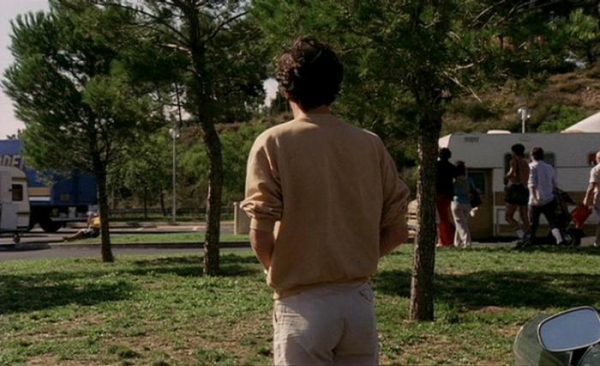
Third Night:
The Vanishing
Michael Haneke has said that he never watched any mainstream horror movies before making Funny Games (1997), which might explain why that film doesn’t ever really look or sound like one of the genre pictures it means to decry. But rewatching the first sequence of The Vanishing (1988), with its shots of cars winding their way down European highways overlaid by the sound of voices playing word games, it’s clear that Haneke had at least a passing familiarity with George Sluizer’s Dutch thriller. (Maybe he saw it at a film festival.) The two films’ openings are nearly identical, both indebted, perhaps, to the portentous overture of The Shining—the use of a bird-of-prey’s-eye perspective to simultaneously introduce the main characters and suggest that they’re driving steadily towards a bad end.
There’s another connection between The Vanishing and Funny Games, which is that both were remade in the United States by their original director with diminishing returns. Haneke’s shot-for-shot redux was more of an auteurist curiosity than an outright failure—it’s hard to imagine that anyone who found the first film profound or distasteful (or profoundly distasteful) would see anything in version 2.0 to change his or her mind. But Sluizer’s second pass at the material in his own 1993 remake was widely considered to be a travesty, with every element that had made The Vanishing a critical and festival hit either downplayed or else seriously deformed in some way. The biggest complaint was that Sluizer undid his own good work in The Vanishing by turning its celebrated and horrifying climax into a mere third-act stumbling block for the protagonist. Instead of being literally and figuratively forced to lie in the death-bed he’s made for himself through his fixation on the years-ago disappearance of his partner at a roadside rest stop, Jeff Harriman (Kiefer Sutherland) gets to live and love another day—and to deliver vengeance to his nemesis (Jeff Bridges, giving the worst performance of his or anybody’s career) by way of a well-placed shovel to the mouth.
Sluizer took plenty of heat for seeming to so fundamentally misunderstand his own achievement in The Vanishing, which was to make a movie in which the villain was definitively triumphant well before such downbeat endings were de rigueur in international genre filmmaking—and also to do so in a way where the grim payoff felt fairly and skillfully engineered instead of cruelly impasted from on high. One of the great things about The Vanishing is how intricately Sluizer and his co-writer Tim Krabbe (who authored the novel on which The Vanishing’s script was based) develop their characters—not only the obsessive Rex Hoffman (Gene Berovets), who is so memorably rooked by the unprepossessing, self-described “sociopath” Raymond Lemorne (Bernard-Pierre Donnadieu), but also Saskia (Johanna Ter Steege), the vanished party, who in her brief screen time registers as much more than a structuring-absence-in-waiting. Her intense reaction early in the film when Rex briefly leaves her in a dark tunnel to fetch gas for their stalled car (they’re Dutch tourists on a biking trip through Paris) suggests a woman whose temperament runs to extremes—the sort of person who might actually storm off for a few hours without warning just to teach him a little lesson about abandonment.
Rex fears losing the one he loves, but then so does Raymond. In the most chilling scene, he frames his (as-yet-unspecified) act of evil as a kind of self-administered psych evaluation: “I logically conceived the most horrible deed that I could envision right at that moment.” What’s truly subtle about The Vanishing is how it lets this admission resonate as something more than a malevolent screenwriter’s gambit. In scene after scene, we see Raymond tenderly interacting with his wife and two daughters, who have prosaic suspicions about his secretive behavior—they wonder if he’s having an affair. He’s at once too vanilla for that (“I am proud of only having ever known one woman,” he tells his wife) and too far gone. Kidnapping and burying a woman alive while her husband agonizes over her whereabouts is the worst thing that he can imagine because it relates to his own great fear—and completes the sophisticated pattern of doubling and substitution that runs through the screenplay (both men have names beginning with R; Rex is compelled to return twice to the scene of the time; and Saskia’s premonitory dream of two golden eggs floating in space pays off in twinned early graves).
The film’s niftiest trick, however, is how it performs the Hanekean feat of implicating the audience while keeping the fourth wall up. Rex’s need to learn what happened to Saskia even after he’s fairly sure that she’s dead mirrors our own frustration with the script’s canny withholding of information, and the protagonist and viewer both get closure, via some funny gamesmanship authored by the antagonist and the filmmaker. The sick joke is just how literal that sense of closure becomes. Like few other genre films before or since, The Vanishing manages to be satisfyingly unsatisfying. It hits the spot—and the nerve. —Adam Nayman
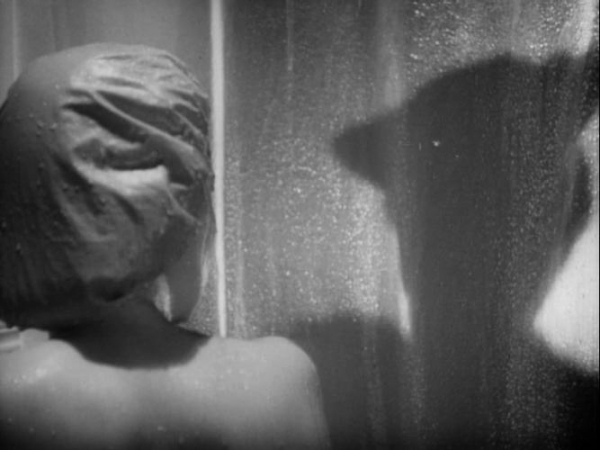
Fourth Night:
The Seventh Victim
Even if you’re familiar with the distinct style of the 1940s horror films Val Lewton made for RKO, such as Cat People, The Leopard Man, and I Walked with a Zombie, his 1943 masterpiece The Seventh Victim still comes as a revelation. One of American cinema’s rare producer-auteurs, Lewton used his limited budgets to his advantage, crafting tales of possession and the occult that utilized off-screen space arguably better than any American filmmaker before or since, locating profound terror in what was just out of the frame. These films are known for their shadowy, deliberately paced set pieces, typified by a hushed, music-free soundtrack punctuated by quick bursts of aural shock. This is horror boiled down to its essence—it’s all about the threat posed to both character and audience. Regardless of the fact that the plots must have come across like nonsense on the page (voodoo, body snatching, manimals!), what was onscreen was irrefutably scary. The Seventh Victim, however, is the most no-nonsense of these films. It was directed by Mark Robson, shockingly in his film debut—a testament to the power of Lewton’s authorial stamp and guidance that it feels so accomplished. A sober, melancholy tale of fragile humanity that only limns the edges of the supernatural, the film is firmly grounded in reality; nevertheless, when it’s over, we feel like we’ve been to hell and back.
The Seventh Victim is constantly crouching, waiting to pounce, breathing down our necks. In her first film role, Kim Hunter is Mary Gibson, forced to leave the cloistered environment of her boarding school to find her older sister, Jacqueline, who has gone missing after making a life for herself in New York’s Greenwich Village. Even in this solemn beginning, the world that Lewton and Robson creates evokes the funereal, the Catholic school identified by overwhelming stained-glass windows and the reverberations of distant hymns. The environment feels sheltered but no less menacing than the world beyond, where Mary will soon get a crash course in life and death, and something terrible in between. Hunter’s search takes her from one nightmarish scenario to the next, starting with the discovery, after convincing her sister’s landlord to open her empty apartment, that Jacqueline has rigged an as-yet-unused noose in the center of her living room. By the time it’s over, the film has supplied so much tension that it's as though we haven’t breathed in 71 minutes. Everything feels both mundane and otherworldly—appropriate for a film that turns out to concern a society of Satan worshipers made up of seemingly ordinary folks living right under our noses.
It’s worth saving the film’s many superb suspense sequences for the uninitiated viewer to discover, but let’s just say that these rank among the greatest that Hitchcock and De Palma never devised: an information-gathering mission at a pitch-black nighttime office that ends in an offscreen stabbing; a surreal subway ride concerning a man who might be a corpse (its tension recalls Dressed to Kill’s heart-racing set piece on the MTA); a scene in which Jacqueline’s imperious former coworker approaches Mary while she’s showering, the shape of her hat making her silhouette on the curtain look like it is sprouting devil horns (anticipating Psycho); and a tour de force, extended final chase through Greenwich Village’s shadowy streets and alleyways in which a woman is tormented by a potential killer, who may be specifically targeting her or just randomly pursuing her (we never find out). All of these sequences are almost entirely without music, and feature razor-sharp editing between stalker and prey, darkness and light. Based on its brilliant technical qualities, The Seventh Victim would just be a superb suspense film; but it’s so much more than this. It’s a film about our ability to be swallowed up by the terrifying world around us, and how we can direct our fates toward either life or death—the scariest idea is that we have the choice.
Hunter is remarkably sympathetic with a minimum of sentimentality, but the film belongs to two other faces: Jean Brooks as the much sought-after Jacqueline, and Elizabeth Russell as Jacqueline’s neighbor, the perpetually ill Mimi (shades of La Bohème), who lives just one apartment over in the same building. With her witchlike black bangs and expressionless, haunted stare, Brooks is the film’s poster child for fear—a woman who’s been manipulated and preyed upon for her weaknesses, exploited for her death drive, and who now lives in the dark recesses of life. Russell is only onscreen for a few scenes, but when The Seventh Victim is over it’s clear that her Mimi has been the film’s residing spirit. We usually only see flashes of her when she briefly comes out of her apartment, coughing and in a ratty bathrobe, and always seen under a sickly, flickering hall light. We find out late in the film that she is dying and has been ill for years. The contrast between the two women leads to a final moment burdened by philosophical weight that’s accomplished with such remarkable, disturbing brevity as to be unequaled in American cinema. It’s all achieved in less than ten seconds of screen time, followed by a line from John Donne, spoken in whispery voice-over: “I run to death, and death meets me as fast, And all my pleasures are like yesterday.” The Seventh Victim haunts as only the greatest poems can. —MK
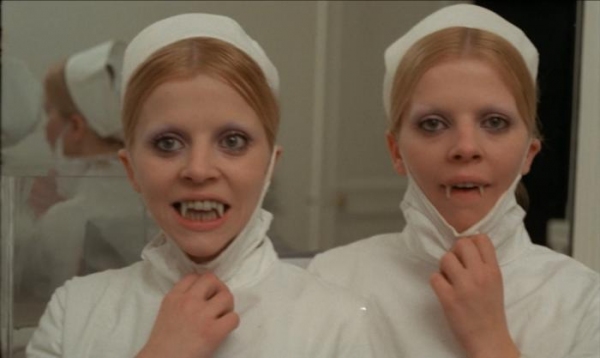
Fifth Night:
Lips of Blood
Discovery remains the height of pleasure for the cinephile, and in the ranks of those movies long forgotten, preserved only on decaying VHS copies and in the pages of The Psychotronic Video Guide, lies fertile potential for both generating highly personal canons and that other favorite cinephilic pastime: arguing. Why sit around tepidly agreeing that Ozu, Tarkovsky, and Hitchcock were pretty good at making movies, when we could be hotly debating the relative merits of more outré talents like Suzuki, Zulawski, Bava, Jodorowsky, H. G. Lewis, et al?
These types of films are also valuable for the more prurient interests they satisfy. Jean Rollin’s 1975 Lips of Blood popped up on my Netflix queue on a slow evening, so, mildly curious, I clicked on it, expecting little. Yet, eighty-something odd minutes of not terribly scary, yet wholly hypnotic vampire softcore later, I found myself launching immediately into a viewing of his earlier The Shiver of the Vampires. Over at Slant, on the occasion of Kino’s Blu-ray release of a handful of Rollin titles, Budd Wilkins referred to him as the “Robert Bresson of Euroshock,” and with the filmmaker’s simple shooting style, deadpan performances (often given by non- or porn actors), Parisian settings, and underlying belief in powers beyond the human, the case is there to be made. Of course, one could just as easily write Rollin off as a peddler of ineptly crafted vampire fantasies notable only for the frequency in which breasts are revealed for no discernible narrative purpose.
I wouldn’t necessarily agree with Wilkins that Lips of Blood is “downright Proustian,” though the tale is jumpstarted by the shock of a memory. After a mysterious prologue in a crypt featuring the entombment of several shrouded bodies, Rollin cuts to a hilariously bland Parisian cocktail party (one guest dispassionately notes that “the Parisian in-crowd can be fascinating”). Leonine Frédéric (Jean-Loup Philippe, also the film’s cowriter) is distracted from a potential conquest by a photograph of a foreboding castle in an ad for the new perfume the party is celebrating. Unsurprisingly, given that Frédéric’s preceding conversation centered on how scents are like memories, the photo kicks Philippe back to his younger self, to experience the memory of a mysterious girl he encountered at the castle in the picture.
Rollin works us into this reverie by visually matching close-ups of older Frédéric staring out of frame to shots of him as a boy, gazing off similarly. With Art Brut films like Rollin’s, the question of intentionality always comes into play, but this quick bit of image-rhyming suggests a filmmaker more in command of the medium’s subtleties than much of the rest of Lips of Blood does. Indeed, once Frédéric begins an investigation into the location of the manse in the photo, vague, mysterious forces toss obstacles, both sexual and violent in his way, though none of the cloak-and-dagger act Rollin puts on really seems to make much sense. This malarkey is intercut with images of a quartet of lady vampires (two nude and two twins; Rollin never explains why the twins aren’t naked and vice versa), who have somehow been awoken by Frédéric’s obsession and seem like they might possibly be tracking him down, though could just as easily be wandering the streets of Paris to satisfy their naked bloodlust.
Frédéric makes it to the castle, and his nearly forgotten love, Jennifer (Annie Briand, a regular in seventies and eighties Euro exploitation films who now plies her trade as a social worker), only to find that the ageless girl is a vampire herself. Frédéric’s overbearing mother and a pack of gruff hirsute types—who look for all the world like they might as easily have been bakers as softcore extras—descend on the scene and task the boy with taking up his true lineage as a vampire killer, demanding that he off the evil Jennifer. He doesn’t, of course, opting instead to fake out the hunters, become a vampire himself, and, in the film’s oddly touching finale, sail with his love, both completely starkers, into the sea snug inside a wooden coffin. Knowing these plot contours shouldn’t really ruin your enjoyment of Rollin’s matter-of-fact implausibility.
When it was released in the U.S.—retitled, crassly, as Suck Me, Vampire—it received an X-rating. But what I’ve enjoyed in the Rollin films I’ve seen has less to do with its scandalous aspects—its lusciously contoured vampiresses draped only in diaphanous scarves (often to hilarious effect—you can, at times, spy one of the actresses trying in vain to keep the wind-tossed scarves from enveloping her face or revealing her genitals, often simultaneously), the cheese-ball gore—or even the willful (one hopes) flaunting of narrative logic. Instead, it’s the intense longing and need that drives his heroes’ quests that’s most fascinating. The human-vampire relationship in film and TV these days revolves almost entirely around desire for and denial of sex, but in Rollin the search is for connection, which does often express itself sexually, but seems only part of filling a larger hollowness. It’s hard to make a legitimate case for Lips of Blood on any of the grounds one usually discusses art cinema, and it’s certainly not traditionally scary or gross-out Halloween viewing. Yet there’s a unique ache to Lips of Blood that lingers. —Jeff Reichert
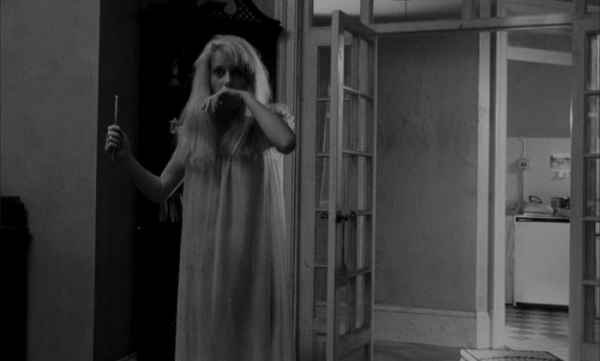
Sixth Night:
Repulsion
Had Carol Ledoux, the Belgian manicurist in Kensington, London, who is the central figure in Roman Polanski’s Repulsion, not looked like the 24-year-old Catherine Deneuve, her psychosis might have played out at a normal pace, eventually depositing her under institutionalized supervision without a murder rap. But her hyper-exaggerated beauty and shyness, which is both natural and a result of her being foreign, bring her unasked-for attention—from her sister’s married boyfriend, Colin (Ian Hendry); a dumbly romantic suitor, Michael (John Fraser); and an oleaginous landlord (Patrick Wymark) seeking to exchange rent owed for sex—that accelerates her dive into extreme insanity. An unfortunately timed abandonment by her roommate/sister (Yvonne Furneaux) for a holiday with the boyfriend frees up the apartment as an echo chamber for her cracked reveries and incubator for the madness that grows in her like the eyes on the potatoes and flies around the jellylike rabbit carcass left to fester in the dank open air.
Deneuve’s long, golden hair and the soft, almost fascistic symmetry of her facial features make her a target for men’s monkeyish reflexes while simultaneously masking her problems behind the visage of an angel, or just another London fashion bird. Strolling down a Kensington street in a cosmopolitan dress to the peppy sounds of Chico Hamilton's jazz score, Deneuve looks like she might’ve strayed from the sets of Swinging London benchmarks Darling or The Knack . . . and How to Get It, both released the same year as Repulsion, 1965. (The timing’s too close for the latter to have been a proper parody, perhaps, but Repulsion still functions as a morbid corrective to the Swinging thing.)
Carol clearly has an unhealthy relationship with hygiene and her own veneer. Her sloppiness is selective — she’ll let a corpse bath overflow but obsessively irons a tanktop (albeit with an unplugged iron). She scratches at invisible lice. For a while, she’s both well-coiffed and fashionably turned out, though it’s likely that Carol is unaware of her beauty, which is part of what makes attention from anyone other than her sister a stressful nuisance. There’s a moment when Carol analyzes her convexly warped reflection in a teakettle with some horror, possibly a hint at how she privately views her appearance.
Carol is prone to shutting down like a low-battery robot at work (romantically and incorrectly called “daydreaming” by coworker Bridget), her first outward signals of distress along with her persistent frowning. She shows genuine humane concern when Bridget (Helen Fraser) is crying about a boy, but returns immediately to her dissociative disconnect (staring at a chair and brushing off probably nonexistent dirt) when the other woman leaves the room. A client assumes she “must be in love or something,” but there are no cute explanations offered when her distracted cuticle-snipping leads to gore, my pick for the most unbearable moment in a movie whose violence earned it an X certificate in Britain.
The vile landlord excepted, the men in Repulsion are guilty only of misguided wooing (Michael) and general boorishness (Colin puts his toothbrush in Carol’s glass), one way in which the film avoids being anything so trashy as rape-revenge. There is some hint, by the way to which it’s repeatedly referred throughout and meticulously lit in the final, showy shot, that an old family photograph implies mistreatment of some kind by Carol's father, years ago. The man who treats her worst—and who may or may not be an incarnation of Michael, Colin, her father, etc.—is the sooty, imagined (?) intruder who appears in a mirror, routinely rapes her, and gropes at her with rubbery arms reaching through the riven walls. These nightmares make a case for Repression as an adequate alternate title. If Repulsion leans on any horror trope, it’s the what-happens-next exploitation of mental illness as shockfest—perfectly defensible here, as in Psycho or Carrie, due to the director’s artistry and ability to make the audience empathize with his protagonist.
Repulsion and the later Rosemary's Baby and The Tenant form Polanski’s “apartment trilogy,” though it seems unnecessary to limit it by real-estate type when the potential energy of horror in confined environments is also so crucial in Cul-de-sac, Macbeth, Death and the Maiden, The Pianist, and Carnage. You don’t get the sense that Carol would be significantly better off on an open air farm, with its different species of madness-nourishing silence as well as bumps in the night, though there she wouldn’t be gawked at by the hag across the hall, or menaced by horny landlords and narrow corridors. And she wouldn’t have such a good view of the nuns across the street incessantly playing “ball”—an unnerving sight, possibly reminiscent to Carol of something in girlhood, and echoed in The Tenant’s bouncing red ball turned severed head.
Polanski’s mastery is remarkable in only his second feature film and on a relatively small budget. Cinematographer Gil Taylor turns a confined space into a topsy-turvy hell house using wide-angle distortion, while Hamilton’s score increases in dark feverishness as Carol goes from the seeming carefree mademoiselle of the early walks to the nose-flicking, wild-eyed floor-writher. Polanski is not above shock tactics, and they work. There is one tender moment when it looks like there might be hope for Carol, as she laughs along girlishly to her coworker describing Chaplin in The Gold Rush. But when her friend goes to hand Carol her purse, we see the rabbit’s rotting head inside. —Justin Stewart
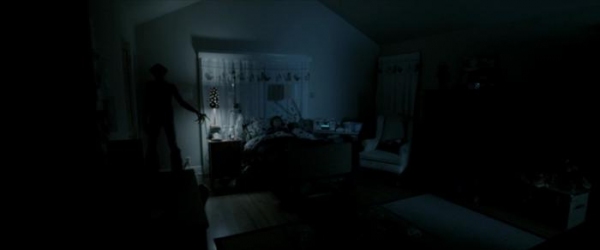
Seventh Night:
Insidious
Most of the selections for this year’s Great Pumpkins series—and from past editions—have offered scares of the slowly creeping kind. These are films that sneak up on you and stick like barnacles on the brain long past whatever momentary shocks they offer. And these are often the kinds of films that, for good reason, get the most critical or scholarly respect. If you can’t shake it, then it must have registered on a more profound level. But there’s also something to be said for horror movies that don’t crouch as much as pounce. Films that mean to give the viewer a series of well-timed jolts are often considered cheap, but such entertainments are also purely cinematic—there’s no other art form that does precisely this, that can even approximate their kind of tension and release, created through image and sound. That said, movies designed to make the audience jump in fright are a dime a dozen; those that do it well are few and far between. That’s why a film such as James Wan’s Insidious, for all the derivative mumbo-jumbo in its narrative, stands out like a diamond in the rough—or a gleaming pair of eyes in the pitch-black dark.
Unoriginal to the point of self-parody, Insidious is nevertheless the most effective American scare machine of the past few years. It offers the kind of plot that allows its shocks to take on a variety of forms, and thus never feel repetitive, moving from things-that-go-bump-in-the-night to demon faces at the window to possessions and séances. This October’s Sinister managed to sustain a high level of tension in a similarly stripped-down, cursed-house scenario, but it often relied on an unpleasant dose of sadism to plunge its viewers into darkness; here, it’s all about possibility—what is in the shadows, what the threat is and where it’s going to come from. Its forebears are clear—child whose spirit needs to be reclaimed from a dark netherworld (Poltergeist); a portal being opened up to a new dimension unleashing a gallery of grotesques (Hellraiser); a haunting that turns out to be connected to an individual rather than a house (Paranormal Activity')—yet while watching it none of that matters because you’re too enshrouded in darkness to even see the references.
Another surprise about Insidious—a film from the folks who sicced the Saw series on the world and then gave us the ventriloquist’s-dummy goof Dead Silence—is that it feels grounded in a relatively authentic domestic reality. If it doesn’t approach the nonchalant verisimilitude of the opening scenes of Poltergeist (sort of a benchmark of naturalism within a supernatural context), the first act of Insidious nevertheless places us in a recognizably human realm, helped immeasurably by the persuasive performances of Rose Byrne and Patrick Wilson as Renai and Josh, an attractive young couple with two sons and a baby who have moved to a new home; he’s a grade-school teacher, she’s a songwriter trying to get her career back on track after a recent pregnancy. Normally horror-movie characters such as these are saddled with some tragic backstory they will have to overcome through a terrifying series of deathly trials, but Renai and Josh are just average parents whose routine is upended when their oldest son, Dalton, falls into a mysterious coma. Around the same time, a series of seemingly unrelated, unexplainable disturbances begin occurring around the house; first, as these things tend to happen, they begin as strange voices picked up as eerie static on the baby monitor, and soon it’s clear there are malevolent intruders sneaking about.
Like most films about hauntings, there isn’t much rationale for why the ghosts start out as teasing and playful only to turn devilish and dangerous; it has less to do with narrative logic than the ways a film builds up tension to sufficiently prey on the audience’s emotions. This usually results in horror movies being particularly strong in their first halves, pregnant as they are with the intimation of the unknown. Insidious is a textbook example of this, as its superb setup yields a succession of genuinely frightening scares, all of them made possible through pinpoint-precise camera framing and arresting sound flourishes. As the threat gets ever closer, Wan unleashes a series of disquieting images that come at us in fleeting glimpses: a face peering out from behind the netting above a baby’s crib; shadowy figures pacing back and forth beyond—and then in front of—a bedroom window; a demon’s silhouette reaching out one clawed hand towards a sleeping child; in a shocking cut, a monstrous crimson face peering out with gaping mouth from behind an unaware Josh. The shocks are so exquisitely timed and paced, and the contents of the shots are so classical in nature, Insidious often feels like a return to a popular art form that’s been lost amidst decades of the genre being mired in gore and simplistic cruelty.
Yet in addition to establishing its surreal twilight world of horrors with aplomb, Insidious manages to keep refreshing itself. Almost each new plot development functions in pushing the film into unsettling and well-realized new territory, literally into a “further” realm, as the medium (Lin Shaye) dubs the netherworld where Dalton has been trapped. At first, the spirits seem to primarily torment Renai; yet Josh, like most men in horror films a supernatural skeptic, becomes the focal point as the film transitions. In this second half—often where horror films fall apart with dull overexplication—the film comes alive again with a virtuoso and rather quirky séance; a third-act twist involving Josh’s own haunted childhood, complete with disturbing photographic evidence; and a trip into the “further” elegantly and imaginatively evoked on the film’s limited budget with a single lantern, a host of hideously painted faces, and a whole lot of thick, pitch darkness. There’s a Lynchian integrity to the sheer blackness of the surreal nighttime world Wan creates in this climax, and a strange clarity to the fearful pictures that spring from the void. Insidious may ultimately be made up of jolts, but just because it’s scary in the moment doesn’t make its moment any less valid. It’s as ephemeral as Halloween. —MK
